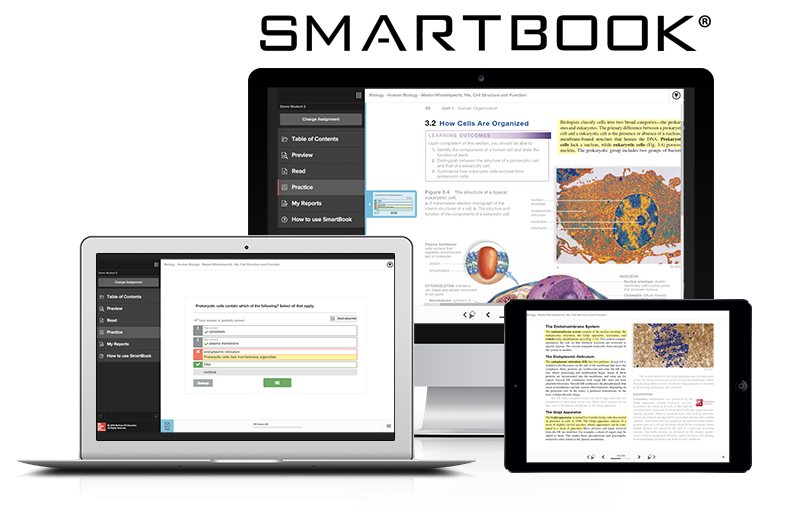What is it?
Electronic textbooks, commonly referred to as e-textbooks, digital textbooks, or e-texts, are electronic versions of a text that can be read on a desktop, mobile device, or ereader device. Electronic textbooks may include part or all of the printed text version. It may also include additional content, such as multimedia content and hyperlinks, that would be impossible to render in a printed text. Some electronic textbooks may also include interactive content, self-assessments, or guided questions that provide real-time feedback. Interactive course content is often proprietary to the publisher and can include resources such as online homework assignments, quizzes, and instructor presentations.
How does it work?
Key Features: The features most commonly found across e-textbooks include the ability to search through the text, digitally annotate, highlight, comment, and track pages read. Some e-textbooks allow students to download the book to their device and access it through an “offline” mode. With limitations, some e-texts offer printing capabilities as well.
Format: While there is a universal electronic format known as ‘epub,’ many publishers may have proprietary formats that may either require downloading a specific reader or requires special access to an online environment. This is especially true for e-textbooks that provide interactive and multimedia content as part of their textbook packages.
Purchasing: Students can choose to buy, rent, or check out e-textbooks from a variety of sources -- namely, their campus bookstore, book retailers and renters, and libraries. Book rentals and library loans restrict the amount of time that a student can gain access to an e-text. For example, a student who chooses to rent a math e-textbook through their campus bookstore will receive an individualized access code which will then be used to login and access their online textbook environment. The access code is only valid for a limited time (for example, one or two semesters), after which the student will lose access to their e-textbook.
Who’s doing it?
Students: As e-textbook use in the K-12 level is growing, students may enter the higher education environment with the expectation of using e-textbooks. For example, Florida counties have set aside half of materials funding toward the purchase of digital materials [1]. However, some evidence suggests that students have a greater preference for paper textbooks – even students who have used e-textbooks in the past [2].
Faculty: Generally, faculty members who want to integrate e-textbooks in their courses, either exclusively or as an alternative to paper-based books, can select the option in the textbook adoption process. At the University of Miami, faculty members can adopt textbooks through the university bookstore’s online textbook option system once registering for an account. [3].
Intitutions: Some colleges and universities have pursued institution-wide e-textbook adoption. These initiatives typically approach the integration of reduced-cost e-textbooks through publisher partnerships and multi‐institutional e-textbook pilots. Modelled on an e-textbook pilot at Indiana University [4], a partnership between Internet2, McGraw-Hill, Courseload forged a pilot in Spring 2012 of e-texts with institutions, University of Wisconsin, University of Minnesota, Cornell University, University of Virginia [5][6]. In a low-cost e-textbook approach, OpenStax develops free, peer-reviewed, openly licensed textbooks for introductory college courses; their Institutional Partnership Program annually recognizes universities who use free, peer-reviewed textbooks on campus [7].
Why is it significant?
Adoption of e-textbooks may depend on perceived usefulness [8] and the supplementary resources they provide to navigate and fill in certain topics [9]. As such, educators within higher education institutions often have an influential role over what texts are used in their courses which can determine how and when learners interact with assigned course materials [8]. If e-textbooks are provided as an alternative resource, students can have the opportunity to decide and engage with assigned course material through their preferred format and device. However, as quality, accessibility, and platform of e-textbooks differ per provider, determining if an e-textbook is a viable alternative resource falls on the educator. Adopting or creating an e-textbook, similar to any course material, requires evaluation, to ensure the outcomes of the course, align with the purpose of the learning resource. To support adoption of e-textbooks, University of Central Florida aims to track and champion instructor-designed digital resources, expand faculty development in e-textbook selection and fund further research in e-textbook effectiveness [8].
What are the downsides?
- Limited Availability: The most evident downside to e-textbooks is that not all publishers may provide them for a given text. This is particularly true for specialized materials or small print run books.
- Change of Medium: E-textbooks also have no physicality, reducing the tactility and manipulability that some people prefer and enjoy in paper books. Some students might feel that paper books are easier to highlight or jot down margin notes in.
- Reuse Restrictions: When a text is offered exclusively in an e-textbook format, the possibility for students to purchase used copies is no longer an option, eliminating an age-old cost savings measure for students on a budget. Furthermore, some e-textbooks are coupled with license restrictions that remove access to the book to students after a certain period of time.
- Reduced Control of Content: In some cases, the additional interactive content or practice exercises bundled with some of the more technologically advanced forms of e-textbooks may lead to some faculty members feeling as though they have reduced control of the curriculum or the learning experience.
- ADA Compliance: The exclusive adoption of an e-textbook format may also require evaluation to ensure compliance with accessibility requirements.
- Power: E-textbooks require devices that must have batteries or power to access the content; this has implications not only for forgetful students, but possibly a much wider audience in the case of long-term weather-related power outages.
Where is it going?
As e-textbook usage grows, new and more robust features are added to proprietary platforms which claim to assist with content mastery. Recent reports from education publishers identify sales of digital course materials surpass sales of print textbooks [10]. For example, McGraw-Hill offers “SmartBook,” which personalizes the content students see using data analytics. The next generation of e-texts may include fully built learning environments [11], featuring simulations, learning analytics, and collaboration, such as the ability for the instructor to share their highlights and notes with students.

The digital reading environment is still subject to technological change and disruption [8]. As a result, e-textbooks continue to evolve and vary by producer. As new technology comes out, there may be future iterations that significantly impact use and adoption, therefore it is important to remain flexible and informed.
What are the implications for teaching and learning?
The overall teaching and learning implications of e-textbooks are fairly insignificant; both traditional paper textbooks and e-textbooks are fundamentally just content delivery mechanisms. The difference between print and e-textbooks are more often detected in the additional online content that publishers may provide with their textbooks. If there is significant online content included with the textbooks (which can be print or electronic in format), there is more opportunity for students to engage in the material, particularly if there are online assessments and homework exercises. Unfortunately, there may also be an opportunity for a higher level of plagiarism, as electronic content can be leaked.
The interactive functionality coupled with some (but not many) e-textbooks may provide opportunities for additional engagement or practice with the course material. The search functionality in e-books increases ease of access to on-demand information. In other words, it may be easier to do a keyword search for “mitosis” and see it in context than to flip back and forth from the index of a paper book.
Much more critical to an effective and engaging learning environment than the format of the textbook is the instructor’s pedagogical approach and relationships with students. However, e-textbooks are associated with a number of potential small benefits that may render them useful in some contexts.






